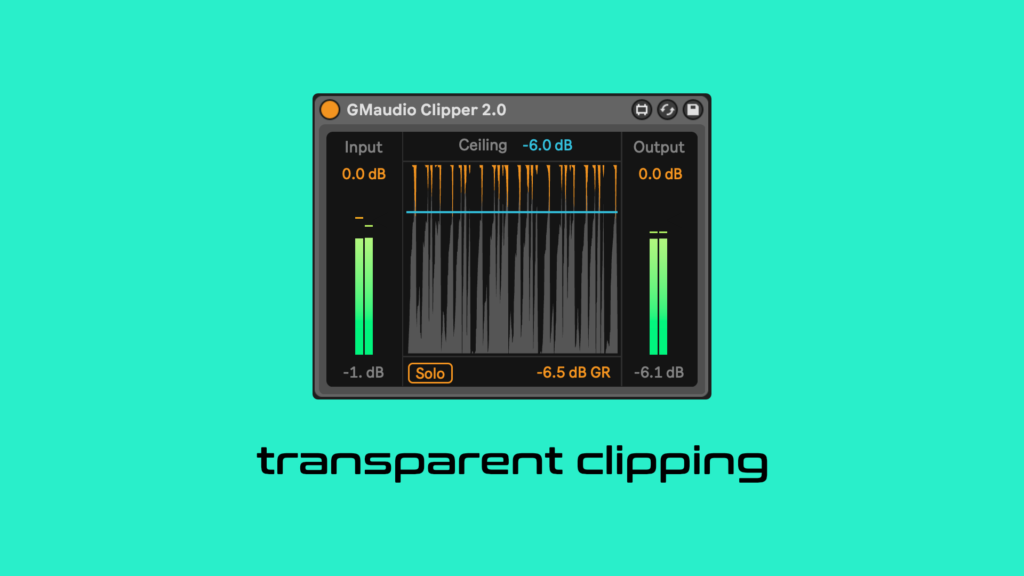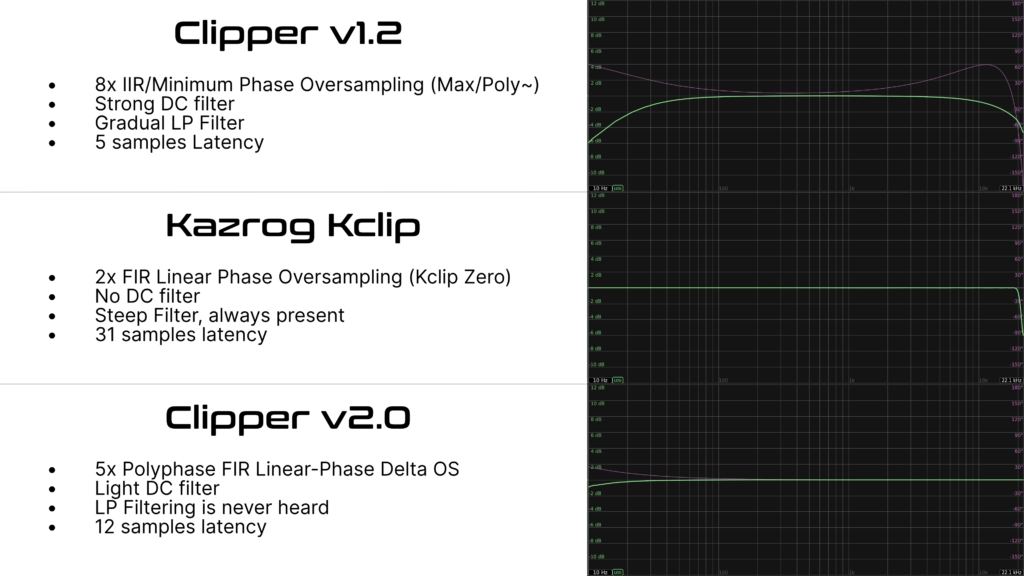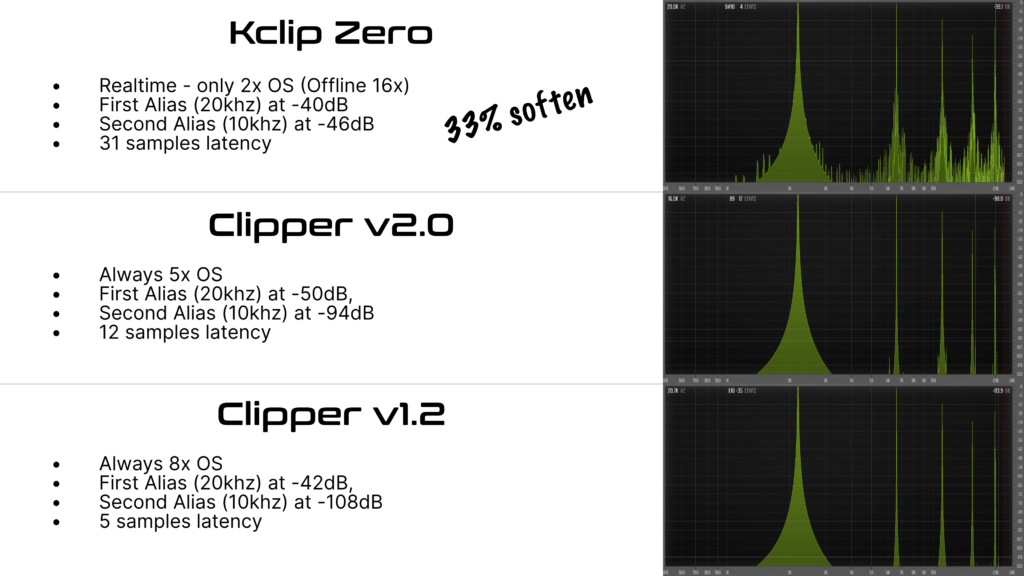Squeeze every last drop out of GMaudio Squeeze!
Squeeze every last drop with GMaudio GMaudio Squeeze is a Multi-band Upward Compressor. Its effects can range from normalization and loudness enhancement, to complete sonic

What makes GMaudio Clipper 2.0 the best clipper for Ableton Live?
Its industry leading oversampling of course, making it the first Max For Live device of its kind, but what does that actually mean?
I’m glad you asked! Because of the extra distortion that a clipper adds, it is very much at the risk of introducing Aliasing. Aliasing occurs when you try to sample (create and store) a signal that is higher in frequency than half of the sample rate, otherwise known as Nyquist. Whatever exceeds Nyquist is then folded back or mirrored into the original signal.
Aliasing is often louder in the high frequencies and can mask finer details in this area, it can be characterized as noisy, brittle and ‘digital’ sounding. To reduce aliasing we need to temporarily increase the sample rate, so the processing can take place without the risk of aliasing, then filter out any information that would otherwise alias, and return to the original sample rate.
Without going too deep, there are a number of ways this can be achieved but it usually involves performing the process a number of times and then interpolating the result, which requires the use of a low pass filter. This filter is applied to the audio signal and changes the sound, therefore the design of this filter will determine the sonic signature of the oversampling algorithm.
In filter design there are two main categories. IIR, or infinite impulse response filters, and FIR, or finite response filters. This is basically a fancy way of saying that one uses feedback and is therefore infinite, while the other does not and therefore must be finite.
IIR filters are usually simple, accurate and efficient. They can approximate simple analog filters with ease but often exhibit phase shift. FIR filters however, can achieve much more accuracy, but at the cost of efficiency. They can also have unique properties such as being Linear-Phase, meaning they will not change the phase at all.
In filter design, this Phase Shift refers to how much the timing of certain frequencies are affected. Phase Shift can colour the sound on its own, you only have to use something like Kilohearts Disperser to know how much of an effect it can have on a sound, mind you that is a very extreme case. Phase Shift is not always undesirable, but if you are trying to colour the sound as little as possible, Linear-Phase FIR filters are often a good choice.
Let me know in the comments if you would like me to discuss Phase Shift in more detail, in future articles.

In this picture im using Bertom’s EQ Curve Analyzer to visualize the frequency and phase response of three clippers.
The first is GMaudio Clipper version 1.2, which uses an IIR low pass filter in the oversampling algorithm, much like the oversampling used in Live’s other audio effects. This oversampling is built into Max and is the only way someone can implement oversampling without writing their own code. The filter is more gradual than the other examples and a small amount of phase shift is present. The second is Kazrog Kclip Zero, a clipper which was recently released. It uses an FIR filter allowing it to be much steeper than an IIR filter and displays no Phase Shift.
Last is GMaudio Clipper version 2.0 which also uses an FIR filter in the oversampling algorithm but has extra steps to make the filter completely invisible unless clipping occurs. These extra steps are referred to as Delta Oversampling, it’s implemented in very few VST/AU plugins and never before in Max For Live, until now.
My previous article explains why this is useful.
Clipper is now at Version 2.4 which has many changes.
Delta Oversampling has its caveats and works best with light clipping,
now you can control exactly how much of the filter you want to disappear using the ‘FIR Remainder’ parameter.
All of these changes are explained here.
Both GMaudio clippers have a DC filter, this is used to remove any DC offset before clipping and ensures that the signal is centered around the zero crossing, so that the clipping is always symmetrical and the sound is more predictable. Clipper 2.0 uses a custom DC offset filter, which is basically a high pass filter at 0Hz.
The final comparison we can make here, is the amount of latency. Latency is the time it takes for the output to be ready for listening, if something has a higher latency, then it often means that more processing is taking place, which can translate into higher CPU usage. A longer FIR filter means increased accuracy but also higher latency, so there is usually a compromise.
The clipper using an IIR filter has a low latency of 5 samples, making it more suitable for real time use. Kazrog Kclip Zero has 31 samples of latency which is less than 1 millisecond, still very usable. GMaudio Clipper 2.0 only has 12 samples of latency, about a quarter of a millisecond, much less than Kclip and many other plugins, it achieves this using a Polyphase FIR filter.
Polyphase basically means that it’s split up into many steps. Using Polyphase FIR oversampling instead of the usual FIR oversampling, means that you can achieve the same length filter at a lower latency, or a longer filter at a similar latency. It can also increase the CPU efficiency of the oversampling algorithm. I designed the filter to be slightly less steep than Kclip and similar plugins, but it starts earlier and filters out more aliasing. GMaudio Clipper 2.0 is the first Max For Live device to ever implement Polyphase FIR oversampling.

In this picture I used Voxengo SPAN to see the aliasing produced by a 2220 Hz sine-wave from Live’s Operator, with 6dB of clipping applied using each clipper.
Hard clipping introduces infinite harmonics so you would need an infinite amount of oversampling to remove it completely, luckily we are using soft clipping instead, but this still requires a considerable amount of oversampling to reduce it to an acceptable level. If no aliasing was present then there would be 4 additional peaks above the sine-wave towards Nyquist, and nothing else. Unfortunately, there is no standard for how much aliasing is acceptable, it depends on the developers goals and the users needs.
Kclip Zero only uses 2x oversampling, so it was always going to fail in comparison to GMaudio Clipper. Kazrog has done this to make it more CPU efficient and lower the latency for real time use but then increases the oversampling when exporting your track.
The problem with this, is that it will sound completely different, the filter will be relatively similar but the aliasing is very much audible during normal playback, influencing your mixing decisions. If you don’t know what it’s going to sound like when you export it, then you can’t make any clear judgments. With a Soften setting of 33%, the knee of this soft clipper is actually slightly more than the 4dB knee of GMaudio Clipper, therefore it should introduce less aliasing, but it still fails miserably during real time playback.
Clipper 2.0 oversamples 5x, meaning the clipping takes place at a much higher sample rate. The first aliased peak, or harmonic that has been folded back into the audio signal, sits at -50dB around 20khz, which is quite good compared to other clippers and is attributed to the design of the filter. The second alias peak is at -94dB which is very close to my goal of the aliasing being below -96dB, or lower than 16 bits.
Clipper 1.2 has 8x oversampling and therefore, the most aliasing rejection, but its first aliased peak is at -42dB because the IIR filter can not be very steep. This makes GMaudio Clipper 2.0 the ideal compromise with its excellent aliasing rejection at only 5x oversampling.
We’ve touched on some very complex topics, Filter Design, Digital Audio and Sampling theory as well as Digital Signal Processing. The result is that GMaudio Clipper 2.0 achieves an ideal balance of latency, CPU efficiency and aliasing rejection while being more transparent than other clippers out there. Best of all, it is easy to use and integrates seamlessly into Ableton Live’s device chain. This makes it the perfect solution for clipping in Ableton Live.
If you would like to learn more about how to use a clipper, then ready my article ‘Clippers Versus Limiters’.
All of these tests are performed with Ableton Live and free software, so they can be easily replicated. If you can find a clipper that has better aliasing rejection, less latency and CPU usage, for a lower price, whether it be a VST/AU plugin or Max For Live device.
Then contact me with details and I will give you a full refund.
Squeeze every last drop with GMaudio GMaudio Squeeze is a Multi-band Upward Compressor. Its effects can range from normalization and loudness enhancement, to complete sonic
There’s no getting around it, mixing electronic music is hard! In this first article I want to highlight what exists when we experience sound while presenting ideas for bringing your music to life!
What makes GMaudio Clipper 2.0 the best clipper for Ableton Live? Its industry leading oversampling of course, making it the first max for live device of its kind, but what does that actually mean?
Are you wondering “how do I use a clipper” or “how does a clipper differ from a limiter”? Then look no further. We will answer both these questions and more, as we compare clippers versus limiters.
Here are 10 steps you can follow to learn Ableton Live, inside and out!
Create complex melodic patterns from a simple, one note input.
2 Responses
Since posting this article, I have updated GMaudio Clipper to Version 2.1. This disables the DC Offset filter by default so that it is more transparent from the start, it can then be enabled later in the new Options menu.
I also took the opportunity to add some features/changes requested by customers. I made the Knee adjustable from the front panel, so now you can get less aliasing with higher Knee values or distort more of the signal, using it more like a saturator.
I also added another clipping algorithm to the final output that uses Anti-Derivative Anti-Aliasing and hard clipping at the original Sample-Rate to keep the final output at 0dB or below, this does colour the sound when it is enabled but is useful in some situations.
These changes make GMaudio Clipper even more versatile and demonstrate my devotion to delivering the best to my customers. The rest of the changes in Version 2.1 are listed here: https://robertkgm.gumroad.com/p/m4l-update-gmaudio-clipper-2-1-improvements-feature-requests
Happy Music Making!
Clipper 2.4 is now available! Lots of changes since version 2.1, all of which are explained here…
Happy Music Making!